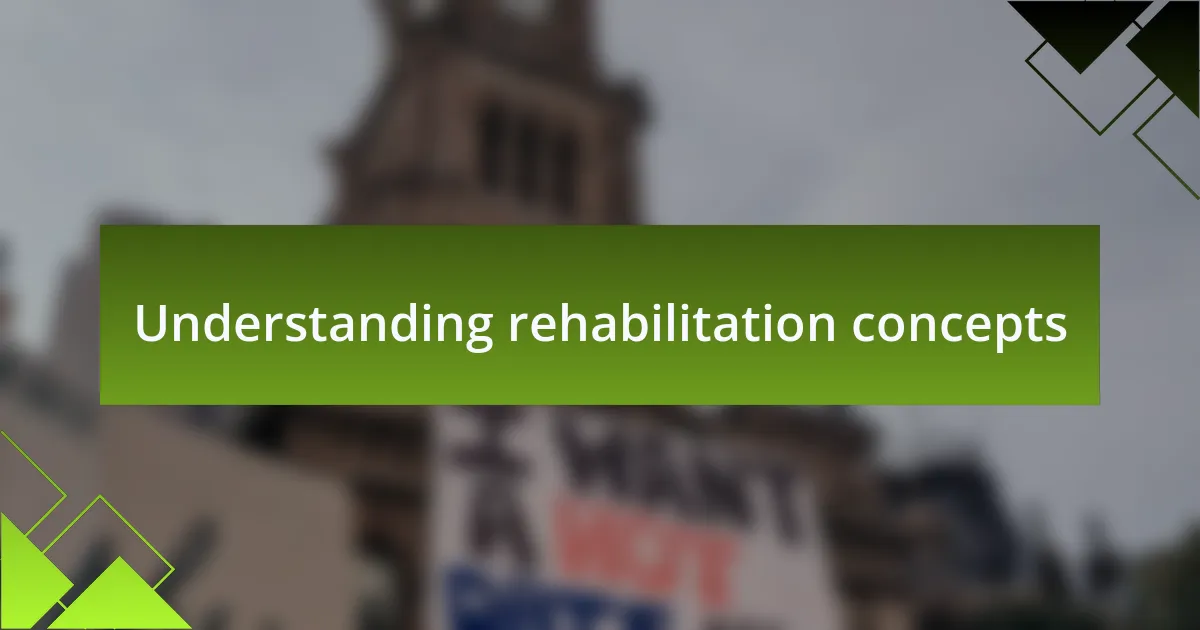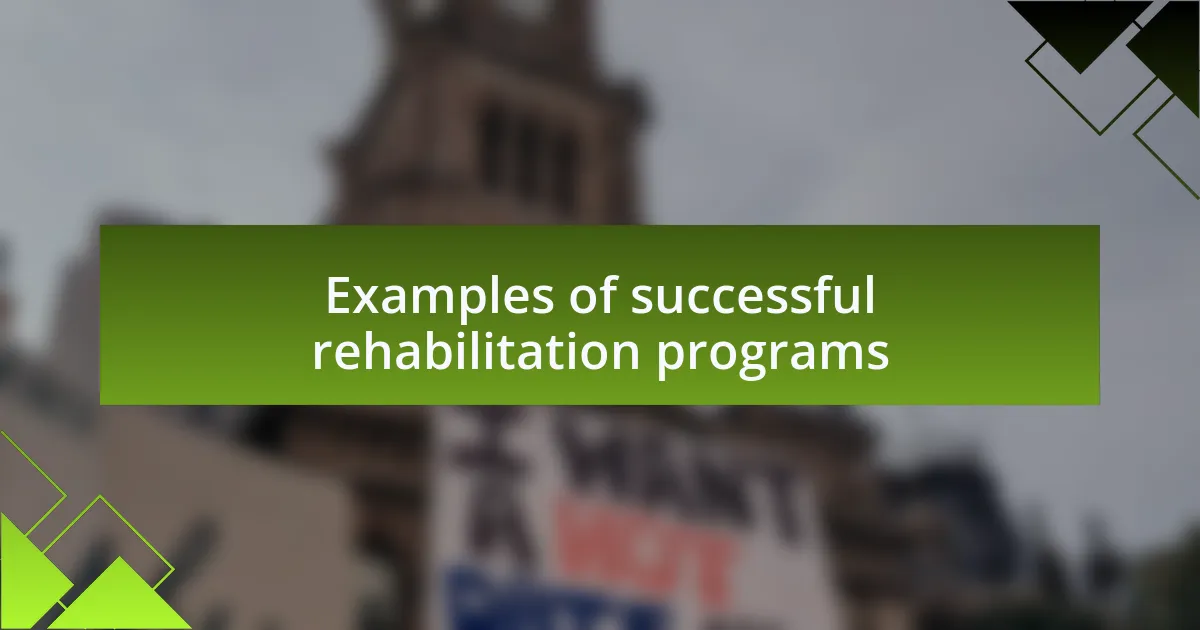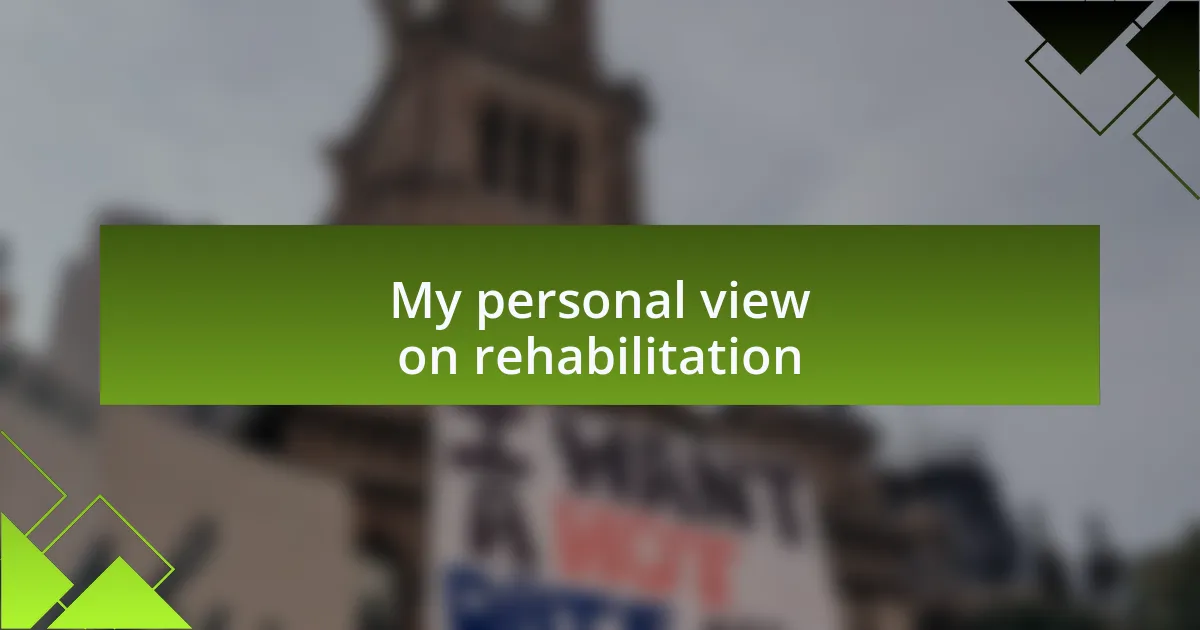Key takeaways:
- Rehabilitation focuses on transforming lives by addressing root causes of criminal behavior, such as poverty and trauma, rather than solely punishing individuals.
- Successful rehabilitation programs significantly reduce recidivism rates, showing that investment in personal growth contributes to safer communities.
- Examples like the Norway prison system illustrate how humane treatment and support can lead to successful reintegration and personal development for former inmates.
- A sense of community and belonging is crucial in rehabilitation, as it encourages individuals to take responsibility and pursue positive changes in their lives.

Understanding rehabilitation concepts
Rehabilitation is fundamentally about transforming lives rather than simply punishing. I remember sitting in a community meeting where a former inmate shared his journey of change. It struck me how powerful it is to hear someone talk about overcoming their past mistakes and embracing a new, constructive identity. Isn’t it inspiring to think that with the right support and resources, anyone can find a path to redemption?
At its core, rehabilitation seeks to understand the underlying issues that lead to criminal behavior. During my time volunteering at a local outreach program, I met individuals whose circumstances—like poverty, trauma, and lack of education—contributed to their actions. This experience taught me that addressing those root causes is vital to fostering genuine change in individuals and, ultimately, society. How often do we consider these deeper struggles when we label someone a criminal?
I often reflect on the connection between rehabilitation and community support. It’s fascinating how a solid support system can be the difference between reoffending and successful reintegration. While talking with mentors who work in rehabilitation, I learned that their approach goes beyond therapy or education; it’s about building relationships that foster trust and hope. Can we really expect someone to change if they don’t feel accepted and valued?

Benefits of rehabilitation over punishment
Rehabilitation offers an opportunity to rebuild lives, a stark contrast to punishment, which often perpetuates a cycle of despair. I recall attending a rehabilitation workshop where a participant shared their experience with substance abuse. Hearing their candid reflections on how effective treatment reconnected them with their family made me realize that when we focus on healing rather than retribution, we pave the way for genuine transformation.
Another aspect that struck me is the significant reduction in recidivism rates associated with rehabilitation programs. During a discussion with several mentors in the field, they highlighted that individuals who complete rehabilitation are far less likely to reoffend. This points to a compelling truth: investing in people’s potential not only changes lives but also contributes to safer communities. Isn’t it remarkable how a little support can cut down crime rates?
Moreover, embracing rehabilitation fosters a sense of accountability. I remember meeting a young man who had completed a program and was now working with at-risk youth. His journey toward taking responsibility for his actions demonstrated not just personal growth but also a commitment to making amends within the community. Isn’t it inspiring to see how one person’s transformation can spark a ripple effect, encouraging others to pursue their own paths to redemption?

Examples of successful rehabilitation programs
Rehabilitation programs have taken many forms, often tailored to address the complexities of individual needs. For instance, I participated in a community-based initiative where mentors guided former offenders in acquiring job skills. Witnessing someone’s excitement as they landed their first job left a lasting impression on me. Isn’t it incredible how the right guidance can unlock potential and alter a life trajectory?
One shining example of successful rehabilitation is the Norway prison system, which emphasizes restorative justice. In visiting a facility there, I noticed how the environment fosters respect and personal growth. Inmates engage in meaningful work and education, which not only equips them with skills but also nurtures their self-worth. Isn’t it eye-opening to recognize that humane treatment can lead to thriving citizens upon their release?
In a local program I learned about, participants involved in art therapy found a profound means of expressing their struggles and healing. Artists showcased their work in a gallery, effectively sharing their stories with the community. The emotional response I observed from attendees highlighted the power of art to bridge gaps and foster understanding. How often do we overlook the transformative power of creative expression in the healing process?

My personal view on rehabilitation
My personal view on rehabilitation is rooted in the belief that everyone deserves a second chance. I remember a conversation I had with a former inmate who shared how a mentorship program changed his life. Hearing him express his gratitude for the opportunity to learn and grow made me realize how vital support systems are in breaking the cycle of reoffending.
When I think about the transformative power of rehabilitation, I can’t help but reflect on the stories I’ve encountered. One individual I met spoke about the struggles he faced after his release. But through a focused rehabilitation program that prioritized mental health and skills training, he regained confidence and found a way back to society. It made me wonder, why should we deny individuals the tools they need to succeed?
Rehabilitation is not just about avoiding future crimes; it’s about fostering a sense of belonging and purpose. I have seen firsthand how community engagement can uplift someone who feels isolated and marginalized. It prompts me to ask: Isn’t it worth investing in a future where people can contribute positively rather than being defined by past mistakes?